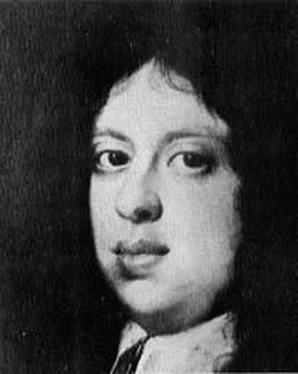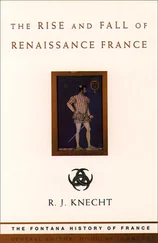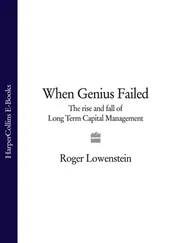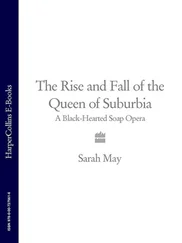Yet however demanding, capricious and arrogant her servants and attendants found her, Eleonora was a good wife to Cosimo, who loved her as much as it was in his nature to love anyone. Soon after their marriage they moved from the Medici Palace to the Palazzo Vecchio which was transformed into the ducal palace with apartments for the Duchess on the upper floors, for the Duke on the lower, and for his mother on the floor between. Neither the Duke nor the Duchess got on very well with his mother, who had never been easy to love and who became increasingly irritating and increasingly untidy as she grew older. On one occasion at least she and her son had a blazing row when he was ill in bed and her fussy interference exasperated him even more than his doctors’ incompetence. He lost his temper with her; she left the room in tears; and the next day they declined to speak to each other. With his wife, however, Cosimo seems always to have remained on excellent terms, allowing her without complaint to indulge her passion for gambling, and never showing irritation at her exasperating changes of mind. She, for her part, put up complaisantly with his secretiveness, his outbursts of ill temper and his long periods of gloomy silence. They seem to have had differences only over the upbringing of their children.
There were five sons – Francesco, the heir; Giovanni, who became a cardinal at seventeen and died of a ‘malignant fever’ two years later; Ferdinando, who also became a cardinal and later Grand Duke of Tuscany; Garzia, who died at the age of seventeen, a fortnight after Giovanni; and Pietro, who was born in 1554. There were also three girls, Maria, Isabella and Lucrezia. All the girls were brought up strictly in the Spanish way, being rarely allowed outside the palace except to go to Mass, seeing few men other than priests, doctors and tutors. Both Maria and Lucrezia died when young, Maria when she was seventeen, Lucrezia at sixteen, less than a year after her marriage to Alfonso d’Este, Duke of Ferrara. Isabella, who was married to Paolo Giordano Orsini and went to live in the Medici Palace, survived only to be murdered by her husband. Cosimo did not live to hear of this tragedy; but on learning of the death of Maria, who succumbed to malaria while they were staying at the castle at Leghorn, he went out onto the bastion alone so that no one should see him give way to his grief. ‘Her constitution was like mine,’ he said forlornly. ‘She ought to have been allowed more fresh air.’ On his return to Florence he continued to mourn for her, and spent hours by himself in his room where her portrait hung on the wall.
But he was never, even in less distressing times, a man who seemed to take much pleasure in life, except in hunting. He was rarely seen to smile; he had a poor appetite, contenting himself with the plainest food and in his later years with one simple meal a day; he had no taste for wine; he usually wore a black velvet robe indoors and used to say he would have preferred to wear a plain Florentine lucco . His apartments in the Palazzo Vecchio were richly decorated, but he chose to sleep in a sombre room whose walls were hung with dark green and blue gold-stamped leather. He would have been just as satisfied, so it was felt, with rooms of monastic simplicity such as those used by his secretaries who had to make do with ‘three desks, two brass lamps, two benches and four large stone inkstands’.
These secretaries worked inordinately long hours, as he did himself. He was up and dressed at dawn, reading and answering the correspondence which he allowed no one else to see, marking documents, compiling reports, writing instructions for his secretaries to copy, impatient to be out-of-doors, complaining when heavy rain kept him at his desk, ‘I am sitting here like a falcon on its perch.’ His paperwork finished, he would go to Mass, usually in the Cathedral, sometimes in the church of the Santissima Annunziata; and afterwards he would play tennis or go out for a walk or a ride in the town, not for pleasure but for exercise. If on foot he always walked fast, wearing a coat of mail under his jerkin, a sword and a dagger hanging from his belt, and with ‘numerous small stiletti , with very sharp points, almost as fine as needles, stuck into the lining of his scabbard as into a needle-case’. He was invariably accompanied by a Swiss bodyguard.
Cosimo had good reason to fear assassination. Several attempts were made on his life; and the savage punishments inflicted on the would-be assassins did not deter others from trying to murder him. One Giuliano Buonnaccorsi, who had planned to shoot him from a window, was tortured with red-hot pincers, dragged round the streets by his ankles, disembowelled and tossed into the Arno. Yet soon afterwards Cosimo’s agents discovered another plot to kill him by submerging a chevaux de frise of swords and spikes beneath the waters of the Arno at the place where he used to dive in for a swim during the summer months.
Ever since 1546 Cosimo had been thinking of bringing all the scattered judicial and administrative offices of Florence, as well as the city’s major guilds, under one roof near the Palazzo Vecchio and hence under his own closer, more personal and efficient control. He appointed Giorgio Vasari his architect, and work on the huge new building, the Uffizi, began in 1559. 4A year later the Duke and his family moved from the Palazzo Vecchio across the Arno to the Palazzo Pitti, the vast palace which Luca Pitti had begun to build a hundred years before. The Duchess had bought the palace from the Pitti family for 9,000 florins in 1549, and instructions had been given to Bartolommeo Ammanati to enlarge and embellish it. 5Work was still being carried out on the great courtyard and on the new ‘kneeling windows’ on the ground floor of the façade when the family moved in, as the Duchess had refused to consider delaying her departure from the Palazzo Vecchio. She had been impatient to enjoy the more spacious splendour of the Pitti Palace, to be able to walk in lovely gardens with magnificent views instead of up and down the small enclosed terrace at the Palazzo Vecchio which was all the space she had there for her rare plants and flowers.
Behind the Pitti Palace, or the Ducal Palace as it was now officially known, were acres of land stretching south to the heights of San Giorgio and west almost as far as the Porta Romana. These had been bought from a variety of families including the Bogoli, and it was by a corrupt form of their name, Boboli, that the gardens laid out there were subsequently known. For ten years up to his death in 1550 the landscaping had been in the hands of Niccolò Pericoli Tribolo, who had designed the big amphitheatre and the pond behind it to be known as the Neptune Pond. Since then the work had been in the hands of Buontalenti, Giulio and Alfonso Parigi, and of Baccio Bandinelli, who had designed an elaborate rustic grotto at the Duchess’s suggestion. 6
The Duchess’s impatience to move to the new palace was aggravated by her failing health. She was now ‘always indisposed’, the Venetian ambassador reported, suffering from a chronic cough and ‘every morning bringing up her food’. She feared she did not have long to live, and her fears were justified. Within less than two years of leaving the Palazzo Vecchio, a fortnight after the death of her favourite son, Garzia, she too died, ‘grieving and despairing, refusing to be guided by physicians as was her wont’. Cosimo was with her at the end, holding her in his arms. As when Maria died he refused to be comforted, shutting himself away from everyone to grieve alone, instructing his eldest son, Francesco, not to attempt to console him for that would only make his loss all the more unbearable. He never fully recovered from it, and in June 1564 he delegated most of his duties to his heir.
Читать дальше












